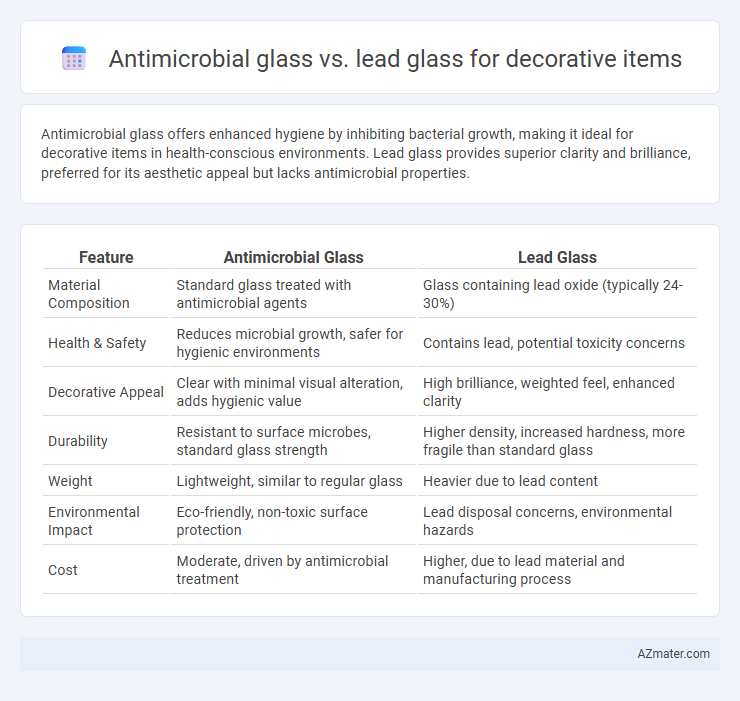Antimicrobial glass offers enhanced hygiene by inhibiting bacterial growth, making it ideal for decorative items in health-conscious environments. Lead glass provides superior clarity and brilliance, preferred for its aesthetic appeal but lacks antimicrobial properties.
Table of Comparison
| Feature | Antimicrobial Glass | Lead Glass |
|---|---|---|
| Material Composition | Standard glass treated with antimicrobial agents | Glass containing lead oxide (typically 24-30%) |
| Health & Safety | Reduces microbial growth, safer for hygienic environments | Contains lead, potential toxicity concerns |
| Decorative Appeal | Clear with minimal visual alteration, adds hygienic value | High brilliance, weighted feel, enhanced clarity |
| Durability | Resistant to surface microbes, standard glass strength | Higher density, increased hardness, more fragile than standard glass |
| Weight | Lightweight, similar to regular glass | Heavier due to lead content |
| Environmental Impact | Eco-friendly, non-toxic surface protection | Lead disposal concerns, environmental hazards |
| Cost | Moderate, driven by antimicrobial treatment | Higher, due to lead material and manufacturing process |
Introduction to Decorative Glass Applications
Antimicrobial glass offers enhanced hygiene by inhibiting the growth of bacteria and viruses, making it ideal for decorative applications in healthcare and high-touch environments. Lead glass, known for its brilliance and clarity due to high refractive index, remains popular in luxury decorative items like chandeliers and fine glassware. Selecting between antimicrobial glass and lead glass depends on the desired balance between health safety features and aesthetic qualities in decorative products.
Understanding Antimicrobial Glass: Features and Benefits
Antimicrobial glass incorporates silver ion technology that inhibits the growth of bacteria, mold, and fungi, making it ideal for decorative items requiring hygiene and durability. Unlike lead glass, which primarily enhances clarity and weight, antimicrobial glass offers added health benefits by reducing microbial contamination on surfaces. Its scratch resistance and ease of cleaning extend the lifespan and aesthetic appeal of decorative pieces in residential and commercial settings.
Lead Glass: Traditional Choice and Its Properties
Lead glass, known for its high refractive index and brilliance, remains a traditional choice for decorative items due to its exceptional clarity and weight. Its dense composition enhances light refraction, creating a sparkling effect ideal for luxury glassware and ornamental pieces. However, lead glass lacks antimicrobial properties, posing potential hygiene concerns compared to antimicrobial glass options in high-touch decorative environments.
Aesthetics: Visual Appeal of Antimicrobial vs Lead Glass
Antimicrobial glass offers a clear, pristine surface with enhanced clarity and resistance to smudges and stains, maintaining its visual appeal over time without compromising hygiene. Lead glass, known for its high refractive index, provides exceptional brilliance and sparkle with a warmer, richer tone that enhances decorative items' elegance. While lead glass excels in light refraction and weight, antimicrobial glass balances aesthetic clarity with health benefits, making it ideal for modern decorative applications where both beauty and cleanliness are prioritized.
Health and Safety Considerations in Decorative Glass
Antimicrobial glass offers enhanced protection by inhibiting bacterial growth on surfaces, making it a safer choice for decorative items in health-conscious environments compared to lead glass, which contains toxic lead that poses health risks upon prolonged exposure or breakage. Lead glass, while prized for its brilliance and weight, requires careful handling and disposal to prevent lead poisoning, especially in households with children or pets. Prioritizing antimicrobial glass ensures both aesthetic appeal and improved hygiene, aligning with modern health and safety standards for decorative glass products.
Durability: Comparing Longevity and Maintenance
Antimicrobial glass offers enhanced durability by resisting bacterial growth and reducing surface degradation, leading to longer-lasting clarity and fewer cleaning requirements. Lead glass, while prized for its brilliance and weight, tends to be more prone to scratches and requires careful handling and maintenance to preserve its appearance. In terms of longevity, antimicrobial glass typically outperforms lead glass due to its resilient surface and lower maintenance demands.
Environmental Impact: Sustainable Decorative Solutions
Antimicrobial glass offers a sustainable decorative solution by reducing the need for chemical cleaning agents, lowering environmental pollution compared to traditional lead glass, which poses toxicity risks during production and disposal. Lead glass, while visually appealing, contributes to heavy metal contamination in soil and water, raising concerns over ecological and human health impact. Choosing antimicrobial glass supports eco-friendly practices by enhancing hygiene and durability without compromising environmental safety.
Cost Analysis: Budgeting for Decorative Glass
Antimicrobial glass typically commands a higher price than lead glass due to advanced coating technologies that inhibit microbial growth, impacting overall budgeting for decorative items. Lead glass, known for its brilliance and weight, offers a more cost-effective option but lacks the health benefits of antimicrobial properties, influencing long-term maintenance expenses. Choosing between antimicrobial and lead glass depends on balancing initial procurement costs with added value factors like hygiene and durability in decorative applications.
Market Trends: Consumer Preferences in Decorative Glass
Antimicrobial glass is gaining notable traction in the decorative glass market due to increasing consumer demand for hygiene and safety in home and office environments. Lead glass, prized for its brilliance and weight, remains favored for luxury decorative items but faces declining preference amid health concerns linked to lead toxicity. Market trends indicate a shift towards sustainable and functional decorative glass, positioning antimicrobial glass as a preferred choice for modern consumers seeking both aesthetic appeal and safety.
Final Recommendations: Choosing the Right Glass for Decor
Antimicrobial glass offers superior hygiene benefits with its ability to inhibit microbial growth, making it ideal for decorative items in settings requiring enhanced cleanliness, such as hospitals or kitchens. Lead glass, known for its high refractive index and brilliance, provides unmatched aesthetic appeal and sparkle, preferred for decorative pieces emphasizing luxury and visual impact. Selecting the right glass depends on the primary function: prioritize antimicrobial glass for health-conscious environments and lead glass for elegance and visual sophistication in decor.

Infographic: Antimicrobial glass vs Lead glass for Decorative item
 azmater.com
azmater.com